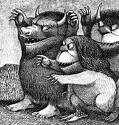 In the middle of the San Francisco Contemporary Jewish Museum‘s (CJM) exhibition of works by the illustrator and children’s book author Maurice Sendak is a picture of one of the scariest looking chickens you ever saw. Painted in kaleidoscope colors with tail feathers more dense and intimidating than the flora of an exotic jungle, legs and claws as thick and gnarled as ancient tree trunks and an imperious look in its eye, the bird couldn’t possibly look less benign. You have to take a step away from the wall to remind yourself that you’re not looking at the globe’s next major global threat, but a cartoon drawing of livestock.
In the middle of the San Francisco Contemporary Jewish Museum‘s (CJM) exhibition of works by the illustrator and children’s book author Maurice Sendak is a picture of one of the scariest looking chickens you ever saw. Painted in kaleidoscope colors with tail feathers more dense and intimidating than the flora of an exotic jungle, legs and claws as thick and gnarled as ancient tree trunks and an imperious look in its eye, the bird couldn’t possibly look less benign. You have to take a step away from the wall to remind yourself that you’re not looking at the globe’s next major global threat, but a cartoon drawing of livestock.
Many images in the CJM’s Sendak exhibition have this — or the opposite — effect on the viewer. The most benign creature has a sinister quality about it; and the most hideous of all ogres possesses an angelic soul.
Take the many illustrations of monsters on display. They have pointy teeth and enormous claws. They look like they should be able to eat a small boy for lunch. Yet there’s something so magnetic about the way in which the artist draws faces and creates poses for his characters, that even the scariest-looking beasties seem approachable. In one memorable image from the show, for instance, a couple of simple worry lines added below the eyes of a hairy monster gives the creature a human personality. People wear their concerns in this way.
The exhibition sets out to demonstrate the partially-hidden “other story” in Sendak’s work. Looking at the pictures is a game of trying to uncover the sub-meanings beneath the alternately cute- or cruel-seeming canvases.
Solving the puzzles is fun. But the lengthy and sometimes unhelpful descriptive plaques that explain the mysteries to museum-goers are rambling and heavy-handed in places. And the fact that the exhibition is curated within the walls of a Jewish museum also imposes meaning upon the images that may not necessarily be as overt a part of their makeup as the museum would have us think. References to the Holocaust and Sendak’s difficult childhood abound. Knowing about the influence of 20th century Jewish history on the artist’s work provides a fascinating context for the double meanings in his art. But the curatorial Holocaust descriptives are so over-labored that they come to define the pictures, in the end skewing our view of the artist’s legacy.
In the end, I found myself tuning out the Jewish stuff and simply enjoying Sendak’s sublime sense of the ridiculous. His pictures of kids in zippered wolf costumes and zany approach to child etiquette in the book What Do You Do, Dear? touched me most of all.
